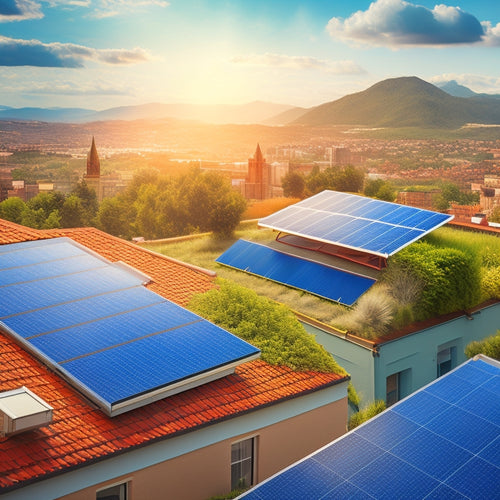
10 Ways to Link Solar Panels With Home Outlets
Share
You'll need to guarantee compliance with local outlet safety regulations and verify your solar panel installation meets specific wiring specifications. Confirm your solar panel system's electrical output matches your home's wiring, and position outlets near the electrical panel for ideal energy flow. Use specialized wiring and connectors for secure connections, and consider DC to AC inversion with an inverter that can handle your system's DC output. Integrate smart plugs for real-time energy usage tracking, and investigate energy storage systems and grid tie inverter setup. By following these steps, you'll be well on your way to efficiently linking your solar panels with your home outlets, and there's more to investigate in order to maximize your renewable energy potential.
Key Takeaways
- Ensure solar panel installation compliance with local outlet safety regulations and consult licensed electricians for guidance.
- Verify electrical output of solar panel system matches home wiring to avoid electrical shock or fire hazards.
- Position solar outlets near the electrical panel for optimal energy flow, minimizing wiring length and ensuring accessibility for maintenance.
- Utilize specialized wiring and connectors for secure connections, adhering to local electrical codes and regulations.
- Integrate smart plugs to track real-time energy usage, identify areas to reduce energy consumption, and maximize solar output.
Solar Panel to Outlet Wiring
When setting up a solar panel system, one essential step is connecting the panels to your home's outlets, which requires careful attention to wiring details.
You'll need to verify that your solar panel installation meets outlet safety regulations, which vary by region. Check local building codes and consult with a licensed electrician if needed.
As you design your system, consider the benefits of solar-powered charging to reduce your carbon footprint and energy costs. Additionally, integrating energy storage systems can enhance grid resiliency and optimize charging efficiency.
Use the correct gauge wire to handle the voltage and current output of your solar panels. Proper wiring will prevent overheating, electrical shock, and even fires.
Remember to label and organize your wires clearly, making it easier to troubleshoot any issues that may arise.
Smart Plug Energy Monitoring
How can you optimize your solar-powered home's energy efficiency? One effective way is through smart plug energy monitoring.
By integrating smart plugs into your home's electrical system, you can track energy usage in real-time, identifying areas where you can cut back and maximize your solar power output.
For instance, regular maintenance, including cleaning, is essential for solar panel performance and energy efficiency solar panel maintenance.
This smart home integration provides you with actionable energy efficiency tips, enabling you to take control of your energy consumption.
With smart plug energy monitoring, you can optimize your energy usage, reduce waste, and enjoy the freedom of a more sustainable lifestyle.
Inverter Compatibility Solutions
Your solar-powered home's energy efficiency relies on the seamless integration of its components. When it comes to inverter compatibility solutions, you'll need to take into account the type of inverter that suits your system.
There are string inverters, microinverters, and power optimizers, each with its own strengths and weaknesses. String inverters are cost-effective but may not perform well with shaded panels, which can be a concern in sites with obstacles. Conducting a shade analysis can help evaluate potential shading impacts on energy output.
Microinverters, on the other hand, provide maximum flexibility but are more expensive. Power optimizers offer a balance between the two.
When installing your inverter, verify it's compatible with your solar panel array and follows local electrical codes. Proper installation tips include placing the inverter in a well-ventilated area, away from water and extreme temperatures.
DC Power Conversion Systems
You'll need to understand the basics of DC power conversion to effectively link your solar panels with home outlets. This involves converting the DC power generated by your solar panels into AC power that's compatible with your home's electrical system.
Solar inverter systems, which greatly reduce energy costs and carbon footprint renewable energy integration, play an essential role in this process.
You'll want to investigate DC to AC inversion techniques and evaluate efficient power conversion systems to minimize energy losses and maximize your solar power output.
DC Power Conversion Basics
As solar panels generate direct current (DC) power, an essential step in linking them with home outlets lies in converting this DC power into alternating current (AC) power, which is what most homes and businesses use.
You'll need to understand the basics of DC power conversion to maximize your solar panel efficiency. By integrating solar power systems with EV charging, you can markedly reduce greenhouse gas emissions and improve local air quality sustainable option.
DC power conversion involves changing the raw DC energy from your solar panels into a usable format. There are several energy conversion methods to choose from, including pulse-width modulation, high-frequency conversion, and resonant conversion.
DC to AC Inversion
DC to AC inversion systems, an essential component of DC power conversion, enable the efficient conversion of raw DC energy from solar panels into usable AC power for homes and businesses.
You'll need an inverter that can handle the DC power output from your solar panels, converting it into AC power that matches the frequency and voltage of your electrical grid.
Inverter efficiency is key, as it directly affects the amount of usable power you'll get from your solar panels.
Look for an inverter with high efficiency ratings, typically above 95%, to minimize energy losses during conversion.
Efficient Power Conversion Systems
When it comes to utilizing solar energy, efficient power conversion systems play a vital role in ensuring that the raw DC power generated by solar panels is converted into usable AC power for your home or business. These systems are essential for maximizing solar efficiency and achieving energy independence.
| Conversion Method | Efficiency Rate |
|---|---|
| String Inverter | 95-98% |
| Microinverter | 95-98% |
| Power Optimizer | 97-99% |
| DC-DC Converter | 90-95% |
Outlet-Specific Solar Installation
You'll need to verify that the solar installation is compatible with your home's outlets, which requires a thorough outlet compatibility check.
Next, you'll determine the ideal solar outlet placement to minimize energy loss and maximize efficiency.
Outlet Compatibility Check
Because your solar panel system's electrical output must harmonize with your home's existing wiring, an outlet compatibility check is essential to confirm a seamless integration.
You'll need to identify the outlet types in your home, as some solar panels may require specific connections. Check the voltage requirements of your solar panel system and verify they match the voltage ratings of your outlets.
For instance, if your solar panel system produces 240-volt DC power, you'll need outlets that can handle this voltage.
Verify that your outlets are compatible with the solar panel system's electrical output to avoid any potential electrical shock or fire hazards.
Solar Outlet Placement
Two key factors determine the ideal placement of solar outlets in your home: the location of your solar panel system and the layout of your electrical infrastructure.
You'll want to position your solar outlets near the electrical panel to minimize wiring and optimize energy flow.
Consider the solar outlet design, considering the physical space and aesthetic appeal of your home.
Outlet installation tips include choosing outlets with built-in GFCI protection and surge protection to guarantee safe and reliable energy transfer.
Wiring and Connection
When positioning solar outlets near the electrical panel, the next step is to focus on the wiring and connection of these outlets to the solar panel system.
You'll need to verify that the wiring is compatible with your solar panel integration, supporting efficient energy flow. Proper wiring and connection are essential for home energy efficiency, as they directly impact the performance of your solar panel system.
You'll need to connect the solar outlets to the electrical panel using specialized wiring and connectors, guaranteeing a secure and reliable connection.
Make sure to follow local electrical codes and regulations, and consult a licensed electrician if you're unsure about any aspect of the wiring and connection process.
Energy Storage System Integration
Integrating your solar panel system with an energy storage system allows you to capture excess energy generated during the day for use during the night or on cloudy days, thereby increasing your energy independence.
This setup guarantees a reliable and efficient energy supply, giving you more control over your energy usage.
To achieve this, you'll need to:
-
Select a compatible energy storage system: Choose a system that's designed to work with your solar panel setup and meets your energy needs.
-
Implement battery management: Confirm proper charging and discharging of your batteries to maintain their health and extend their lifespan.
-
Enhance energy efficiency: Configure your system to minimize energy losses and maximize energy output.
- Monitor and maintain your system: Regularly check your system's performance and perform maintenance tasks to guarantee peak energy production and storage.
Grid Tie Inverter Setup
Your grid tie inverter setup plays an essential role in linking your solar panels with home outlets, as it converts the DC power generated by your solar panels into AC power that's synchronized with the grid's frequency and voltage.
When setting up your grid tie inverter, consider inverter sizing to optimize energy efficiency and guarantee compliance with local regulations.
Prioritize installation safety practices to avoid electrical hazards.
Regular system maintenance and home energy audits can help you identify areas for improvement.
Off-Grid Solar Energy Options
You're considering off-grid solar energy options, which involve designing systems that operate independently of the grid.
These off-grid energy systems typically consist of stand-alone power sources, such as solar panels, wind turbines, or hydroelectric generators, that charge a battery bank.
You'll need to evaluate battery backup options to guarantee a reliable supply of power when the sun isn't shining or during periods of high energy demand.
Off-Grid Energy Systems
Off-grid energy systems employ the power of solar energy to provide electricity independently of the grid, offering a reliable and sustainable solution for remote or isolated locations.
You can enjoy the freedom of generating your own electricity, reducing your reliance on public utilities, and minimizing your carbon footprint.
To maximize your off-grid energy system's efficiency, consider the following key components:
-
High-efficiency solar panels: Optimize your solar energy efficiency by selecting panels with high conversion rates.
-
Renewable energy storage: Invest in reliable battery storage solutions to store excess energy for later use.
-
Power inverters: Choose high-quality inverters to convert DC power from your solar panels to AC power for your home.
- Energy monitoring systems: Install monitoring systems to track your energy production, consumption, and storage in real-time.
Stand-Alone Power Sources
Three primary stand-alone power sources are available for off-grid solar energy systems, each designed to provide reliable electricity in remote or isolated locations.
You can choose from portable solar generators, solar-powered fuel cells, or solar-diesel hybrid systems. These solutions offer energy independence, utilizing renewable resources for sustainable living.
They're ideal for off-grid homes, cabins, or camps, where traditional power lines aren't accessible. With advancements in solar innovations, you can enjoy high solar efficiency and effective energy management.
These eco-friendly options provide power resilience, ensuring you stay connected even in harsh weather conditions.
Battery Backup Options
In conjunction with off-grid solar energy systems, battery backup options play an essential role in guaranteeing a steady supply of electricity, particularly during periods of low sunlight or at night.
When considering battery backup options, you'll want to evaluate factors such as battery capacity, which affects the amount of power stored, and solar efficiency, which impacts the amount of energy generated.
Here are key considerations for selecting the right battery backup option:
-
Depth of discharge (DOD): The percentage of the battery's capacity that can be safely used without damaging the battery.
-
Cycle life: The number of charge and discharge cycles a battery can handle before its capacity degrades.
-
Charge and discharge rates: The speed at which the battery can absorb and release energy.
- Compatibility: Verify the battery is compatible with your off-grid solar energy system and other components.
Smart Outlet Energy Automation
Your home's electrical outlets are about to get a whole lot smarter. With smart outlet energy automation, you'll be able to control and monitor your energy usage in real-time. This integration allows you to optimize your energy consumption, reducing waste and saving you money. By connecting your solar panels to smart outlets, you can channel excess energy to specific appliances or devices, ensuring maximum efficiency.
| Feature | Benefit | Smart Home Integration |
|---|---|---|
| Energy Monitoring | Track energy usage by device or appliance | Energy management systems |
| Scheduled Power | Set specific times for devices to turn on/off | Smart home automation |
| Remote Access | Control outlets from your smartphone or tablet | Mobile app integration |
| Energy Prioritization | Allocate energy to critical devices during outages | Smart energy management |
Real-Time Energy Usage Tracking
Clarity emerges when you can visualize your energy usage in real-time. With real-time energy usage tracking, you gain a deeper understanding of your energy consumption patterns. This allows you to make informed decisions about your energy usage, reducing waste and optimizing your solar panel output.
Here are some benefits of real-time energy usage tracking:
-
Instant feedback: See the impact of your energy-saving efforts in real-time.
-
Optimize energy usage: Identify areas of high energy consumption and make adjustments.
-
Maximize solar panel output: Guarantee your solar panels are producing at their maximum capacity.
- Data-driven decisions: Make informed decisions about your energy usage based on objective data.
Frequently Asked Questions
Can I Use Solar Panels to Power My Entire House?
You can power your entire house with solar panels, achieving home energy independence and reaping solar energy benefits like reduced bills and a smaller carbon footprint, but it requires a properly sized system and energy-efficient appliances.
What Is the Average Cost of a Solar Panel Installation?
You'll be shocked to know that the US solar market grew 43% in 2020! Now, about the average cost of a solar panel installation: it's around $15,000 to $30,000, but with solar panel financing and installation incentives, you can slash that number considerably, achieving energy freedom!
Do Solar Panels Work During a Power Outage?
You're wondering if solar panels work during a power outage - the answer is, they don't, unless you have a battery backup system, which provides one of the key solar energy benefits, offering reliable power outage solutions for your home.
Can I Install Solar Panels Myself to Save Money?
Did you know 70% of solar panel owners consider DIY installation? You can join them, but be warned: improper installation can void warranties. Guarantee a safe, efficient DIY solar setup by following expert installation tips, like grounding and wire sizing, to save money and maintain energy independence.
Are Solar Panels Compatible With All Types of Roofs?
You'll need to assess your roof's compatibility with solar panels, considering factors like size, material, and age. Installation requires careful planning for roof types, such as asphalt shingle, metal, or clay tile, ensuring a secure and efficient setup.
Related Posts
-

Why Merge Earth's Heat With Sun's Energy?
You're about to utilize the full potential of renewable energy by combining the Earth's natural heat with the Sun's a...
-

7 Blockchain Tools for Home Energy Management
You can utilize blockchain technology to optimize your home's energy management through innovative solutions like blo...
-

What Roofing Materials Best Protect Our Planet?
As you consider the environmental impact of your building, you're likely to find that the roofing material you choose...


